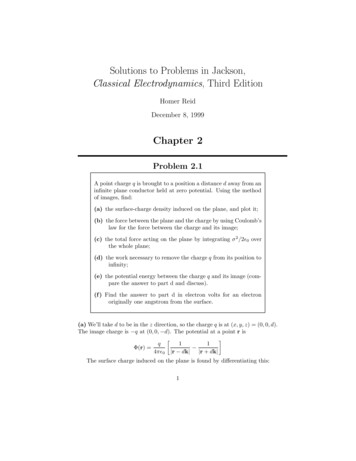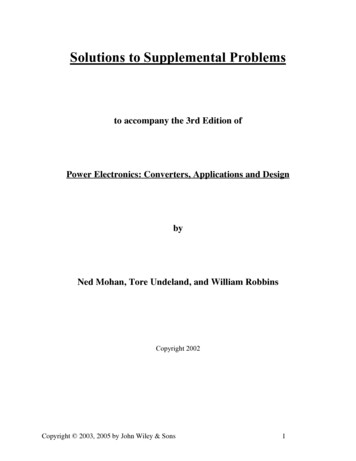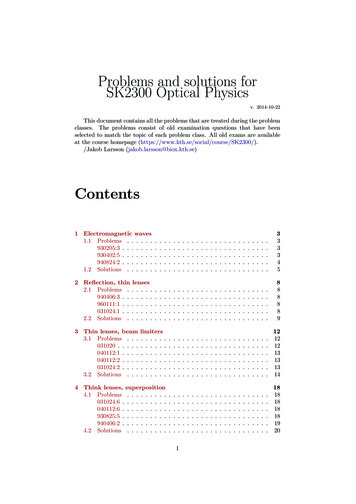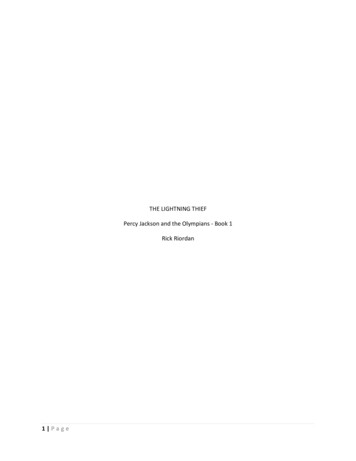
Transcription
Solutions to Problems in Jackson,Classical Electrodynamics, Third EditionHomer ReidDecember 8, 1999Chapter 2Problem 2.1A point charge q is brought to a position a distance d away from aninfinite plane conductor held at zero potential. Using the methodof images, find:(a) the surface-charge density induced on the plane, and plot it;(b) the force between the plane and the charge by using Coulomb’slaw for the force between the charge and its image;(c) the total force acting on the plane by integrating σ 2 /2 0 overthe whole plane;(d) the work necessary to remove the charge q from its position toinfinity;(e) the potential energy between the charge q and its image (compare the answer to part d and discuss).(f ) Find the answer to part d in electron volts for an electronoriginally one angstrom from the surface.(a) We’ll take d to be in the z direction, so the charge q is at (x, y, z) (0, 0, d).The image charge is q at (0, 0, d). The potential at a point r is 11q Φ(r) 4π 0 r dk r dk The surface charge induced on the plane is found by differentiating this:1
2Homer Reid’s Solutions to Jackson Problems: Chapter 2σdΦz 0dz (z d)q (z d) 4π r dk 3 r dk 3qd 2π(x2 y 2 d2 )3/2 0z 0(1)We can check this by integrating this over the entire xy plane and verifyingthat the total charge is just the value q of the image charge:Z Z σ(x, y)dxdy Z Zqd 2πrdψdr2 d2 )3/22π 0(r0Z rdr qd2 d2 )3/2(rZ0qd 3/2 udu2 d2 qd 2u 1/2 2 2d q (b) The point of this problem is that, for points above the z axis, it doesn’tmatter whether there is a charge q at (0, 0, d) or an infinite grounded sheetat z 0. Physics above the z axis is exactly the same whether we have thecharge or the sheet. In particular, the force on the original charge is the samewhether we have the charge or the sheet. That means that, if we assume thesheet is present instead of the charge, it will feel a reaction force equal to whatthe image charge would feel if it were present instead of the sheet. The forceon the image charge would be just F q 2 /16π 0d2 , so this must be what thesheet feels.(c) Total force on sheet Z Z 2π1σ 2 dA2 0 00Zrdrq 2 d2 24π 0 0 (r d2 )3Zq 2 d2 3u du8π 0 d2 q 2 d21 u 28π 022 d q 2 d2 1 4d8π 0 2
Homer Reid’s Solutions to Jackson Problems: Chapter 2 q216π 0 d2in accordance with the discussion and result of part b.(d) Work required to remove charge to infinity Z q2dz4π 0 d (z d)2Z q2u 2 du4π 0 2dq2 14π 0 2dq28π 0 d(e) Potential energy between charge and its image q28π 0 dequal to the result in part d.(f )q28π 0 d (1.6 · 10 19 coulombs )28π(8.85 · 10 12 coulombs V 1 m 1 )(10 10 m ) 7.2 · (1.6 · 10 19 coulombs · 1 V ) 7.2 eV .Problem 2.2Using the method of images, discuss the problem of a point chargeq inside a hollow, grounded, conducting sphere of inner radius a.Find(a) the potential inside the sphere;(b) the induced surface-charge density;(c) the magnitude and direction of the force acting on q.(d) Is there any change in the solution if the sphere is kept at afixed potential V ? If the sphere has a total charge Q on itsinner and outer surfaces?3
4Homer Reid’s Solutions to Jackson Problems: Chapter 2Problem 2.3A straight-line charge with constant linear charge density λ is located perpendicularto the x y plane in the first quadrant at (x0 , y0 ). The intersecting planes x 0, y 0 and y 0, x 0 are conducting boundary surfaces held at zero potential.Consider the potential, fields, and surface charges in the first quadrant.(a) The well-known potential for an isolated line charge at (x0 , y0 ) is Φ(x, y) (λ/4π 0 ) ln(R2 /r2 ), where r2 (x x0 )2 (y y0 )2 and R is a constant.Determine the expression for the potential of the line charge in the presence ofthe intersecting planes. Verify explicitly that the potential and the tangentialelectric field vanish on the boundary surface.(b) Determine the surface charge density σ on the plane y 0, x 0. Plot σ/λversus x for (x0 2, y0 1), (x0 1, y0 1), and (x0 1, y0 2).(c) Show that the total charge (per unit length in z) on the plane y 0, x 0 is 2x0Qx λ tan 1πy0What is the total charge on the plane x 0?(d) Showp that far from the origin [ρ ρ0 , where ρ x20 y02 ] the leading term in the potential isΦ Φasym px2 y 2 and ρ0 4λ (x0 )(y0 )(xy).π 0ρ4Interpret.(a) The potential can be made to vanish on the specified boundary surfacesby pretending that we have three image line charges. Two image charges havecharge density λ and exist at the locations obtained by reflecting the originalimage charge across the x and y axes, respectively. The third image charge hascharge density λ and exists at the location obtained by reflecting the originalcharge through the origin. The resulting potential in the first quadrant isΦ(x, y) λR2R2R2R2ln 2 ln 2 ln 2 ln 24π 0r1r2r3r4r2 r3λln2π 0 r1 r4wherer12 [(x x0 )2 (y y0 )2 ]r22 [(x x0 )2 (y y0 )2 ](2)
5Homer Reid’s Solutions to Jackson Problems: Chapter 2r32 [(x x0 )2 (y y0 )2 ]r42 [(x x0 )2 (y y0 )2 ].From this you can see that when x 0, r1 r2 and r3 r4 when y 0, r1 r3 and r2 r4and in both cases the argument of the logarithm in (2) is unity.(b)σdΦdy 1 dr21 dr31 dr11 dr4λ 2π r2 dyr3 dyr1 dyr4 dy 0y 0We have dr1 /dy (y y0 )/r1 and similarly for the other derivatives, so λ y y0y y0y y0y y0σ y 02πr2r32r12r42 2 11y0 λ π(x x0 )2 y02(x x0 )2 y02 )(c) Total charge per unit length in zZ σdxQx 0 Z Z y0 λdxdx π(x x0 )2 y02(x x0 )2 y0200For the first integral the appropriate substitution is (x x0 ) y0 tan u, dx y0 sec2 udu. A similar substitution works in the second integral.#"ZZ π/2π/2λdu du xπ tan 1 xy0tan 1 y 000 λ ππ 1 x0 1 x0 tan tanπ 2y02y02λx0 tan 1 .(3)πy0The calculations are obviously symmetric with respect to x0 and y0 . Thetotal charge on the plane x 0 is (3) with x0 and y0 interchanged:Qy 2λy0tan 1πx0Since tan 1 x tan 1 (1/x) π/2 the total charge induced isQ λ
Homer Reid’s Solutions to Jackson Problems: Chapter 26which is, of course, also the sum of the charge per unit length of the three imagecharges.(d) We haveΦ λr2 r2ln 22 324π 0 r1 r4Far from the origin,r12 [(x x0 )2 (y y0 )2 ] x0 2y0 222 x (1 ) y (1 )xy y0x022 x (1 2 ) y (1 2xy 2 x 2x0 x y 2 2y0 y) xx0 yy022 (x y ) 1 2 2x y2Similarly,r22r32r42 xx0 yy0 (x y ) 1 2x2 y 2 xx0 yy022 (x y ) 1 2 2x y2 xx0 yy022 (x y ) 1 2x2 y 222Next,r12 r42r22 r32so (xx0 yy0 )2 (x y ) 1 4(x2 y 2 )2 (xx0 yy0 )222 2 (x y ) 1 4(x2 y 2 )222 2 20 yy0 )1 4 (xx222λ(x y ) .Φ ln 20 yy0 )4π 01 4 (xx(x2 y 2 )2The (x2 y 2 ) term in the denominator grows much more quickly than the(xx0 yy0 ) term, so in the asymptotic limit we can use ln(1 ) to find (xx0 yy0 )2λ(xx0 yy0 )2 4Φ 44π 0(x2 y 2 )2(x2 y 2 )2 λ 4(x2 x20 y 2 y02 2xyx0 y0 ) 4(x2 x20 y 2 y02 2xyx0 y0 ) 4π 0(x2 y 2 )2
Homer Reid’s Solutions to Jackson Problems: Chapter 2 7 λ16xyx0 y04π 0 (x2 y 2 )2 4λ (xy)(x0 y0 ).π 0 (x2 y 2 )2Problem 2.4A point charge is placed a distance d R from the center of anequally charged, isolated, conducting sphere of radius R.(a) Inside of what distance from the surface of the sphere is thepoint charge attracted rather than repelled by the chargedsphere?(b) What is the limiting value of the force of attraction when thepoint charge is located a distance a( d R) from the surfaceof the sphere, if a R?(c) What are the results for parts a and b if the charge on thesphere is twice (half) as large as the point charge, but stillthe same sign?Let’s call the point charge q. The charged, isolated sphere may be replacedby two image charges. One image charge, of charge q1 (R/d)q at radiusr1 R2 /d, is needed to make the potential equal at all points on the sphere.The second image charge, of charge q2 q q1 at the center of the sphere,is necessary to recreate the effect of the additional charge on the sphere (the“additional” charge is the extra charge on the sphere left over after you subtractthe surface charge density induced by the point charge q).The force on the point charge is the sum of the forces from the two imagecharges:F"# 14π 0 q2 dRd2 dR 4π 0 [d2 R2 ]2d4qq1qq2 d2R2 2d d(4)(5)As d R the denominator of the first term vanishes, so that term wins,and the overall force is attractive. As d , the denominator of both termslooks like d4 , so the dR terms in the numerator cancel and the overall force isrepulsive.(a) The crossover distance is found by equating the two bracketed terms in (5):
8Homer Reid’s Solutions to Jackson Problems: Chapter 2[d2dR R 2 ]2 d2 dRd4d4 R (d R)[d2 R2 ]20 d5 2d3 R2 2d2 R3 dR4 R5I used GnuPlot to solve this one graphically. The root is d/R 1.6178.(b) The idea here is to set d R a R(1 a/R) and find the limit of (4) asa 0.F " a 2R2 (1 R) (1 a 424a)R (1 RR2 (1 R )2 R2 22 R aR (2R 3a)(R 4a)q 4π 04a2 R2R4q24π 0 R2 (1 aR)aR) #The second term in brackets approaches the constant 2/R 2 as a 0. The firstterm becomes 1/4a2. So we haveF q2.16π 0 a2Note that only the first image charge (the one required to make the sphere anequipotential) contributes to the force as d a. The second image charge,the one which represents the difference between the actual charge on the sphereand the charge induced by the first image, makes no contribution in this limit.That means that the limiting value of the force will be as above regardless ofthe charge on the sphere.(c) If the charge on the sphere is twice the point charge, then q2 2q q1 q(2 R/d). Then (5) becomes dR2d2 dRq2 2 F 4π 0[d R2 ]2d4and the relevant equation becomes0 2d5 4d3 R2 2d2 R3 2dR4 R5 .Again I solved graphically to find d/R 1.43. If the charge on the sphere ishalf the point charge, then dRd2 2dRq2 2 F 4π 0[d R2 ]22d4and the equation is0 d5 2d3 R2 4d2 R3 dR4 2R5 .The root of this one is d/R 1.88.
Homer Reid’s Solutions to Jackson Problems: Chapter 29Problem 2.5(a) Show that the work done to remove the charge q from a distance r a to infinity against the force, Eq. (2.6), of agrounded conducting sphere isW q2 a.8π 0 (r2 a2 )Relate this result to the electrostatic potential, Eq. (2.3),and the energy discussion of Section 1.11.(b) Repeat the calculation of the work done to remove the charge qagainst the force, Eq. (2.9), of an isolated charged conductingsphere. Show that the work done is q2 aq 2 a qQ1. W 4π 0 2(r2 a2 ) 2r2rRelate the work to the electrostatic potential, Eq. (2.8), andthe energy discussion of Section 1.11.(a) The force is F q2 a134π 0 y (1 a2 /y 2 )2directed radially inward. The work isZ W F dyrZ dyq2 a 4π 0 r y 3 (1 a2 /y 2 )2Z ydyq2 a 4π 0 r (y 2 a2 )2Z q2 adu 4π 0 r2 a2 2u2(6) 1q2 a 4π 02u q2 a8π 0 (r2 a2 )r 2 a2(7)To relate this to earlier results, note that the image charge q 0 (a/r)q islocated at radius r 0 a2 /r. The potential energy between the point charge and
10Homer Reid’s Solutions to Jackson Problems: Chapter 2its image isPE 1qq 04π 0 r r0 q 2 a14π 0 r(r a2 /r) q 2 a14π 0 r2 a2(8)Result (7) is only half of (8). This would seem to violate energy conservation. Itwould seem that we could start with the point charge at infinity and allow it tofall in to a distance r from the sphere, liberating a quantity of energy (8), whichwe could store in a battery or something. Then we could expend an energyequal to (7) to remove the charge back to infinity, at which point we wouldbe back where we started, but we would still have half of the energy saved inthe battery. It would seem that we could keep doing this over and over again,storing up as much energy in the battery as we pleased.I think the problem is with equation (8). The traditional expression q1 q2 /4π 0 rfor the potential energy of two charges comes from calculating the work neededto bring one charge from infinity to a distance r from the other charge, and itis assumed that the other charge does not move and keeps a constant chargeduring the process. But in this case one of the charges is a fictitious imagecharge, and as the point charge q is brought in from infinity the image chargemoves out from the center of the sphere, and its charge increases. So the simpleexpression doesn’t work to calculate the potential energy of the configuration,and we should take (7) to be the correct result.(b) In this case there are two image charges: one of the same charge and locationas in part a, and another of charge Q q 0 at the origin. The work needed toremove the point charge q to infinity is the work needed to remove the pointcharge from its image charge, plus the work needed to remove the point chargefrom the extra charge at the origin. We calculated the first contribution above.The second contribution is Z Z q(Q q 0 )dy1qQ q 2 a dy 4π 0 y 24π 0 ry2y3r1qQ q 2 a 24π 0y2y 21qQ q a 24π 0 r2rso the total work done isW 1q2 aq 2 a qQ. 4π 0 2(r2 a2 ) 2r2r r
11Homer Reid’s Solutions to Jackson Problems: Chapter 2Review of Green’s FunctionsSome problems in this and other chapters use the Green’s function technique.It’s useful to review this technique, and also to establish my conventions sinceI define the Green’s function a little differently than Jackson.The whole technique is based on the divergence theorem. Suppose A(x) isa vector valued function defined at each point x within a volume V . ThenZI00( · A(x )) dV A(x0 ) · dA0(9)VSwhere S is the (closed) surface bounding the volume V . If we take A(x) φ(x) ψ(x) where φ and ψ are scalar functions, (9) becomesZV ( φ(x0 )) · ( ψ(x0 )) φ(x0 ) 2 ψ(x0 ) dV 0 Iφ(x0 )S ψ ndA0x0 with the outward normal to the surfacewhere ψ/ n is the dot product of ψarea element. If we write down this equation with φ and ψ switched and subtractthe two, we come up with I Z 2 ψ φdA0 .(10)φφ ψ ψ 2 φ dV 0 ψ n nSVThis statement doesn’t appear to be very useful, since it seems to require thatwe know φ over the whole volume to compute the left side, and both φ and φ/ n on the boundary to compute the right side. However, suppose we couldchoose ψ(x) in a clever way such that 2 ψ δ(x x0 ) for some point x0within the volume. (Since this ψ is a function of x which also depends on x0as a parameter, we might write it as ψx0 (x).) Then we could use the siftingproperty of the delta function to find ZI φ ψx0dA0 . ψx0 (x0 )φ(x0 ) φ(x0 )ψx0 (x0 ) 2 φ(x0 ) dV 0 n x0 n x0VSIf φ is the scalar potential of electrostatics, we know that 2 ψ(x0 ) ρ(x0 )/ 0 ,so we have I Z10000 ψx00 φφ(x0 ) φ(x )ψx0 (x )ρ(x )dV ψx0 (x )dA0 . 0 V n x0 n x0S(11)Equation (11) allows us to find the potential at an arbitrary point x0 aslong as we know ρ within the volume and both φ and φ/ n on the boundary.boundary. Usually we do know ρ within the volume, but we only know either φor φ/ n on the boundary. This lack of knowledge can be accommodated bychoosing ψ such that either its value or its normal derivative vanishes on theboundary surface, so that the term which we can’t evaluate drops out of thesurface integral. More specifically,
Homer Reid’s Solutions to Jackson Problems: Chapter 212 if we know φ but not φ/ n on the boundary (“Dirichlet” boundary conditions), we choose ψ such that ψ 0 on the boundary. ThenZI1 ψx0000φ(x0 ) dA0 .(12)ψx0 (x )ρ(x )dV φ(x0 ) 0 V n x0S if we know φ/ n but not φ on the boundary (“Neumann” boundaryconditions), we choose ψ such that ψ/ n 0 on the boundary. ThenIZ1 φ000φ(x0 ) dA0 .(13)φx0 (x0 )ψx0 (x )ρ(x )dV 0 V nSx0Again, in both cases the function ψx0 (x) has the property that 2 ψx0 (x) δ(x x0 ).
Solutions to Problems in Jackson,Classical Electrodynamics, Third EditionHomer ReidDecember 8, 1999Chapter 2: Problems 11-20Problem 2.11A line charge with linear charge density τ is placed parallel to, and adistance R away from, the axis of a conducting cylinder of radius b heldat fixed voltage such that the potential vanishes at infinity. Find(a) the magnitude and position of the image charge(s);(b) the potential at any point (expressed in polar coordinates with theorigin at the axis of the cylinder and the direction from the originto the line charge as the x axis), including the asymptotic form farfrom the cylinder;(c) the induced surface-charge density, and plot it as a function of anglefor R/b 2,4 in units of τ /2πb;(d) the force on the charge.(a) Drawing an analogy to the similar problem of the point charge outsidethe conducting sphere, we might expect that the potential on the cylinder canbe made constant by placing an image charge within the cylinder on the lineconducting the line charge with the center of the cylinder, i.e. on the x axis.Suppose we put the image charge a distance R0 b from the center of thecylinder and give it a charge density τ . Using the expression quoted in Problem2.3 for the potential of a line charge, the potential at a point x due to the linecharge and its image isΦ(x) τR2R2τlnln 4π 0 x Rî 24π 0 x R0 î 21
2Homer Reid’s Solutions to Jackson Problems: Chapter 2τ x R0 î 2ln.4π 0 x Rî 2 We want to choose R0 such that the potential is constant when x is on thecylinder surface. This requires that the argument of the logarithm be equal tosome constant γ at those points: x R0 î 2 x Rî 2or γb2 R02 2R0 b cos φ γb2 γR2 2γRb cos φ.For this to be true everywhere on the cylinder, the φ term must drop out, whichrequires R0 γR. We can then rearrange the remaining terms to findR0 b2.RThis is also analogous to the point-charge-and-sphere problem, but there aredifferences: in this case the image charge has the same magnitude as the originalline charge, and the potential on the cylinder is constant but not zero.(b) At a point (ρ, φ), we haveΦ τρ2 R02 2ρR0 cos φln 2.4π 0ρ R2 2ρR cos φFor large ρ, this becomes0Φ 1 2 Rρ cos φτln.4π 01 2Rρ cos φUsing ln(1 x) (x x2 /2 · · ·), we haveΦ τ 2(R R0 ) cos φ4π 0ρτ R(1 b2 /R2 ) cos φ2π 0ρ(c)σ 0 Φ ρ r b2b 2R cos φτ2b 2R0 cos φ 4π b2 R02 2bR0 cos φ b2 R2 2bR cos φ"#2b bR cos φb R cos φτ 2π b2 Rb42 2 bR3 cos φ b2 R2 2bR cos φ
Homer Reid’s Solutions to Jackson Problems: Chapter 23Multiplying the first term by R2 /b2 on top and bottom yields"#R2τb bσ 2π R2 b2 2bR cos φ R 2 b2τ 2πb R2 b2 2bR cos φ(d) To find the force on the charge, we note that the potential of the imagecharge isτC2.Φ(x) ln4π 0 x R0 î 2with C some constant. We can differentiate this to find the electric field due tothe image charge:E(x)τ ln x R0 î 24π 0τ 2(x R0 î) .4π 0 x R0 î 2 Φ(x) The original line charge is at x R, y 0, and the field there isE 1τRτî î.2π 0 R R02π 0 R2 b2The force per unit width on the line charge isF τE τ2R2π 0 R2 b2tending to pull the original charge in toward the cylinder.Problem 2.12Starting with the series solution (2.71) for the two-dimensional potentialproblem with the potential specified on the surface of a cylinder of radiusb, evaluate the coefficients formally, substitute them into the series, andsum it to obtain the potential inside the cylinder in the form of Poisson’sintegral:Z 2π1b2 ρ 2Φ(ρ, φ) Φ(b, φ0 ) 2dφ02π 0b ρ2 2bρ cos(φ0 φ)What modification is necessary if the potential is desired in the region ofspace bounded by the cylinder and infinity?
Homer Reid’s Solutions to Jackson Problems: Chapter 24Referring to equation (2.71), we know the bn are all zero, because the lnterm and the negative powers of ρ are singular at the origin. We are left withΦ(ρ, φ) a0 Xn 1ρn {an sin(nφ) bn cos(nφ)} .(1)Multiplying both sides successively by 1, sin n0 φ, and cos n0 φ and integratingat ρ b givesZ 2π1Φ(b, φ)dφ(2)a0 2π 0Z 2π1an Φ(b, φ) sin(nφ)dφ(3)πbn 0Z 2π1bn Φ(b, φ) cos(nφ)dφ.(4)πbn 0Plugging back into (1), we find)(Z 1 2π1 X ρ n000Φ(ρ, φ) [sin(nφ) sin(nφ ) cos(nφ) cos(nφ )] dφ0 Φ(b, φ )π 02 n 1 b)(Z 1 2π1 X ρ n00 cos n(φ φ ) .(5) Φ(b, φ )π 02 n 1 bThe bracketed term can be expressed in closed form. For simplicity definex (ρ/b) and α (φ φ0 ). Then 1 X n x cos(nα)2 n 1 1 1 X n inα x e xn e inα2 2 n 1 1 111 22 2 1 xeiα1 xe iα 1 1 1 xe iα xeiα 1 22 2 1 xeiα xe iα x2 11 x cos α 121 x2 2x cos α1x cos α x2 2 1 x2 2x cos α 11 x2.2 1 x2 2x cos αPlugging this back into (5) gives the advertised result.
Homer Reid’s Solutions to Jackson Problems: Chapter 25Problem 2.13(a) Two halves of a long hollow conducting cylinder of inner radius b areseparated by small lengthwise gaps on each side, and are kept at differentpotentials V1 and V2 . Show that the potential inside is given by V1 V 22bρV1 V 2 1 tancos φΦ(ρ, φ) 2πb2 ρ 2where φ is measured from a plane perpendicular to the plane through thegap.(b) Calculate the surface-charge density on each half of the cylinder.This problem is just like the previous one. Since we are looking for anexpression for the potential within the cylinder, the correct expansion is (1)with expansion coefficients given by (2), (3) and (4):a0 an bn 12πZ2πΦ(b, φ)dφ0Z 2π π1V1dφ V2dφ2π0πV1 V 22 Z πZ 2π1sin(nφ)dφsin(nφ)dφ VV21πbnπ0hi1π2π V cosnφ V cosnφ 120πnπbn1 [V1 (cos nπ 1) V2 (1 cos nπ)]n nπb0, n even2(V1 V2 )/(nπbn ) , n odd Z πZ 2π1cos(nφ)dφcos(nφ)dφ VV21πbnπ0hi1π2πV sinnφ V sinnφ 120πnπbn0. ZWith these coefficients, the potential expansion becomesΦ(ρ, φ) V1 V 22(V1 V2 ) X 1 ρ nsin nφ. 2πn bn odd(6)
6Homer Reid’s Solutions to Jackson Problems: Chapter 2Here we need an auxiliary result:X 1xn sin nφ nn odd 1 X 1(x iy)(iy)n [einπ e inφ ]2inn odd 1 X ( 1)n iφ 2n 1(ye ) (ye iφ )2n 12 n 0 2n 1 1 1 iφtan (ye ) tan 1 (ye iφ )2(7)where in the last line we just identified the Taylor series for the inverse tangentfunction. Next we need an identity: γ1 γ 2 1 1 1tan γ1 tan γ2 tan.1 γ 1 γ2(I derived this one by drawing some triangles and doing some algebra.) Withthis, (7) becomes X 112iy sin φxn sin nφ tan 1n21 y2n odd 2x sin φ1 1tan. 21 x2Using this in (6) with x ρ/b givesV1 V 2V1 V 2 tan 1Φ(ρ, b) ππ 2ρb sin φb2 ρ 2(Evidently, Jackson and I defined the angle φ differently). .
Homer Reid’s Solutions to Jackson Problems: Chapter 27Problem 2.15(a) Show that the Green function G(x, y; x0 , y 0 ) appropriate for Dirichletboundary conditions for a square two-dimensional region, 0 x 1, 0 y 1, has an expansionG(x, y; x0 , y 0 ) 2 Xgn (y, y 0 ) sin(nπx) sin(nπx0 )n 1where gn (y, y 0 ) satisfies 2 2 2 nπgn (y, y 0 ) δ(y 0 y) y 2and gn (y, 0) gn (y, 1) 0.(b) Taking for gn (y, y 0 ) appropriate linear combinations of sinh(nπy 0 )and cosh(nπy 0 ) in the two regions y 0 y and y 0 y, in accord with theboundary conditions and the discontinuity in slope required by the sourcedelta function, show that the explicit form of G isG(x, y; x0 , y 0 ) X1 2sin(nπx) sin(nπx0 ) sinh(nπy ) sinh[nπ(1 y )]nπsinh(nπ)n 1where y (y ) is the smaller (larger) of y and y 0 .(I have taken out a factor 4π from the expressions for gn and G, in accordancewith my convention for Green’s functions; see the Green’s functions reviewabove.)(a) To use as a Green’s function in a Dirichlet boundary value problem G mustsatisfy two conditions. The first is that G vanish on the boundary of the regionof interest. The suggested expansion of G clearly satisfies this. First, sin(nπx0 )is 0 when x0 is 0 or 1. Second, g(y, y 0 ) vanishes when y 0 is 0 or 1. So G(x, y; x0 , y 0 )vanishes for points (x0 , y 0 ) on the boundary.The second condition on G is 2 2 2 G G δ(x x0 ) δ(y y 0 ).(8) x02 y 02With the suggested expansion, we have X 2G 2gn (y, y 0 ) sin(nπx) n2 π 2 sin(nπx0 )02 xn 1 X 02 2G 2g (y, y 0 ) sin(nπx) sin(nπx0 )022 n y yn 1
8Homer Reid’s Solutions to Jackson Problems: Chapter 2We can add these together and use the differential equation satisfied by gn tofind 2 G δ(y y 0 ) · 20 Xsin(nπx) sin(nπx0 )n 1 δ(y y ) · δ(x x0 )since the infinite sum is just a well-known representation of the δ function.(b) The suggestion is to take An1 sinh(nπy 0 ) Bn1 cosh(nπy 0 ),gn (y, y 0 ) An2 sinh(nπy 0 ) Bn2 cosh(nπy 0 ),y 0 y;y 0 y.(9)The idea to use hyperbolic sines and cosines comes from the fact that sinh(nπy)and cosh(nπy) satisfy a homogeneous version of the differential equation for g n(i.e. satisfy that differential equation with the δ function replaced by zero).Thus gn as defined in (9) satisfies its differential equation (at all points excepty y 0 ) for any choice of the As and Bs. This leaves us free to choose thesecoefficients as required to satisfy the boundary conditions and the differentialequation at y y 0 .First let’s consider the boundary conditions. Since y is somewhere between0 and 1, the condition that gn vanish for y 0 0 is only relevant to the top lineof (9), where it requires taking Bn1 0 but leaves An1 undetermined for now.The condition that gn vanish for y 0 1 only affects the lower line of (9), whereit requires that0 An2 sinh(nπ) Bn2 cosh(nπ) (An2 Bn2 )enπ ( An2 Bn2 )e nπ(10)One way to make this work is to takeAn2 Bn2 e nπandBn2 enπ An2 An2 Bn2 enπ .Thenso An2 cosh(nπ)and2An2 enπ e nπBn2 sinh(nπ).With this choice of coefficients, the lower line in (9) becomesgn (y, y 0 ) cosh(nπ) sinh(nπy 0 ) sinh(nπ) cosh(nπy 0 ) sinh[nπ(1 y 0 )] (11)for (y 0 y). Actually, we haven’t completely determined An2 and Bn2 ; we couldmultiply (11) by an arbitrary constant γn and (10) would still be satisfied.Next we need to make sure that the two halves of (9) match up at y 0 y:An1 sinh(nπy) γn sinh[nπ(1 y)].(12)
9Homer Reid’s Solutions to Jackson Problems: Chapter 0.40.60.81yprimeFigure 1: gn (y, y 0 ) from Problem 2.15 with n 5, y .41This obviously happens whenAn1 βn sinh[nπ(1 y)] and γn βn sinh(nπy)where βn is any constant. In other words, we have βn sinh[nπ(1 y)] sinh(nπy 0 ),gn (y, y 0 ) βn sinh[nπ(1 y 0 )] sinh(nπy), βn sinh[nπ(1 y )] sinh(nπy )y 0 y;y 0 y.(13)with y and y defined as in the problem. Figure 1 shows a graph of thisfunction n 5, y .41.The final step is to choose the normalization constant βn such that gn satisfies its differential equation: 2 2 2gn (y, y 0 ) δ(y y 0 ).(14) nπ 2 y 02To say that the left-hand side “equals” the delta function requires two things: that the left-hand side vanish at all points y 0 6 y, and that its integral over any interval (y1 , y2 ) equal 1 if the interval containsthe point y 0 y, and vanish otherwise.The first condition is clearly satisfied regardless of the choice of βn . The secondcondition may be satisfied by making gn continuous, which we have alreadydone, but giving its first derivative a finite jump of unit magnitude at y 0 y:
Homer Reid’s Solutions to Jackson Problems: Chapter 2 gn (y, y 0 ) y 010y 0 y 1.y 0 y Differentiating (13), we find this condition to requirenπβn [ cosh[nπ(1 y)] sinh(nπy) sinh[nπ(1 y)] cosh(nπy)] nπβn sinh(nπ) 1so (14) is satisfied ifβn 1.nπ sinh(nπ)Then (13) isgn (y, y 0 ) sinh[nπ(1 y )] sinh(nπy )nπ sinh(nπ)and the composite Green’s function isG(x, y; x0 , y 0 ) 2 Xgn (y, y 0 ) sin(nπx) sin(nπx0 )n 1 X 2sinh[nπ(1 y )] sinh(nπy ) sin(nπx) sin(nπx0 )(15).nπ sinh(nπ)n 1Problem 2.16A two-dimensional potential exists on a unit square area (0 x 1, 0 y 1) bounded by “surfaces” held at zero potential. Over the entire squarethere is a uniform charge density of unit strength (per unit length in z).Using the Green function of Problem 2.15, show that the solution can bewritten as 4 X sin[(2m 1)πx]cosh[(2m 1)π(y (1/2))]Φ(x, y) 3.1 π 0 m 0(2m 1)3cosh[(2m 1)π/2]Referring to my Green’s functions review above, the potential at a point x0within the square is given by ZI 1 Φ GdA0 .Φ(x0 ) G(x0 ; x0 )G(x0 ; x0 )ρ(x0 )dV 0 Φ(x0 ) 0 V n n00Sxx(16)In this case the surface integral vanishes, because we’re given that Φ vanisheson the boundary, and G vanishes there by construction. We’re also given that
11Homer Reid’s Solutions to Jackson Problems: Chapter 2ρ(x0 )dV 0 dx0 dy 0 throughout the entire volume. Then we can plug in (15) tofindZ 1Z 1 2 X1Φ(x0 ) sinh[nπ(1 y )] sinh(nπy ) sin(nπx0 ) sin(nπx0 )dx0 dy 0 .π 0 n 1 n sinh(nπ) 0 0(17)The integrals can be done separately. The x integral issin(nπx0 )Z1sin(nπx0 )dx00sin(nπx0 ) [cos(nπ) 1]nπ (2 sin(nπx0 ))/nπ , n odd 0, n even(18)The y integral issinh[nπ(1 y0 )] Zy000sinh(nπy )dy sinh(nπy0 )0Z1y0sinh[nπ(1 y 0 )]dy 0o1 ny01sinh[nπ(1 y0 )] · cosh(nπy 0 ) 0 sinh[nπy0 ] · cosh[nπ(1 y 0 )] y0nπ1{sinh[nπ(1 y0 )] cosh(nπy0 ) sinh(nπy0 ) cosh[nπ(1 y0 )] sinh(nπy0 ) sinh[nπ(1 y0 )]}nπ1{sinh[nπ] sinh[nπ(1 y0 )] sinh(nπy0 )}.(19)nπInserting (18) and (19) in (17), we have X sin(nπx0 ) 4sinh[nπ(1 y0 )] sinh(nπy0 )Φ(x0 ) 31 .π 0n3sinh(nπ)n oddThe thing in brackets is equal to what Jackson has, but this is tedious to showso I’ll skip the proof.
12Homer Reid’s Solutions to Jackson Problems: Chapter 2Problem 2.17(a) Construct the free-space Green function G(x, y; x0 , y 0 ) for twodimensional electrostatics by integrating 1/R with respect to z 0 zbetween the limits Z, where Z is taken to be very large. Show thatapart from an inessential constant, the Green function can be writtenalternately asG(x, y; x0 , y 0 ) ln[(x x0 )2 (y y 0 )2 ] ln[ρ2 ρ02 2ρρ0 cos(φ φ0 )].(b) Show explicitly by separation of variables in polar coordinates that theGreen function can be expressed as a Fourier series in the azimuthalcoordinate, 1 X im(φ φ0 )egm (ρ, ρ0 )G 2π where the radial Green
Solutions to Problems in Jackson, Classical Electrodynamics, Third Edition Homer Reid December 8, 1999 Chapter 2 Problem 2.1 A point charge qis brought to a position a distance dawayfrom an in nite plane conductor held at zero potential. Using the method of images, nd: (a) the











